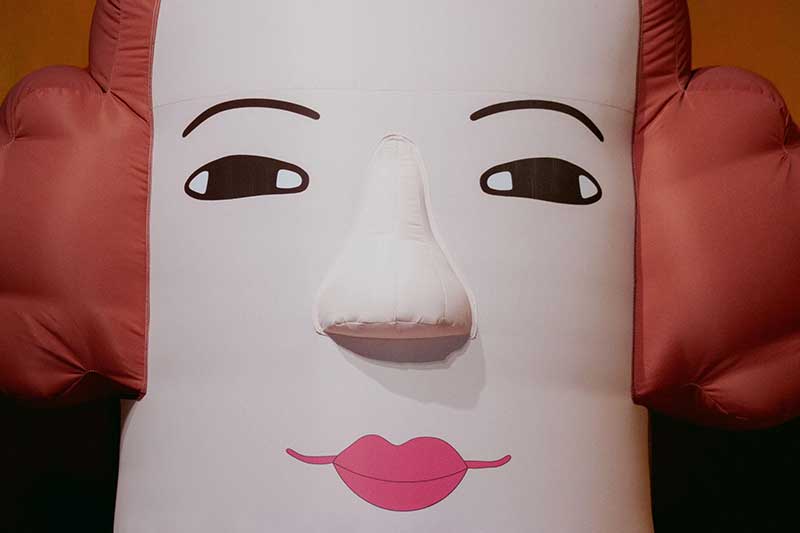Wed July 9th Open 11 AM–5 PM
Physical Space as Vessels for History and Political Power
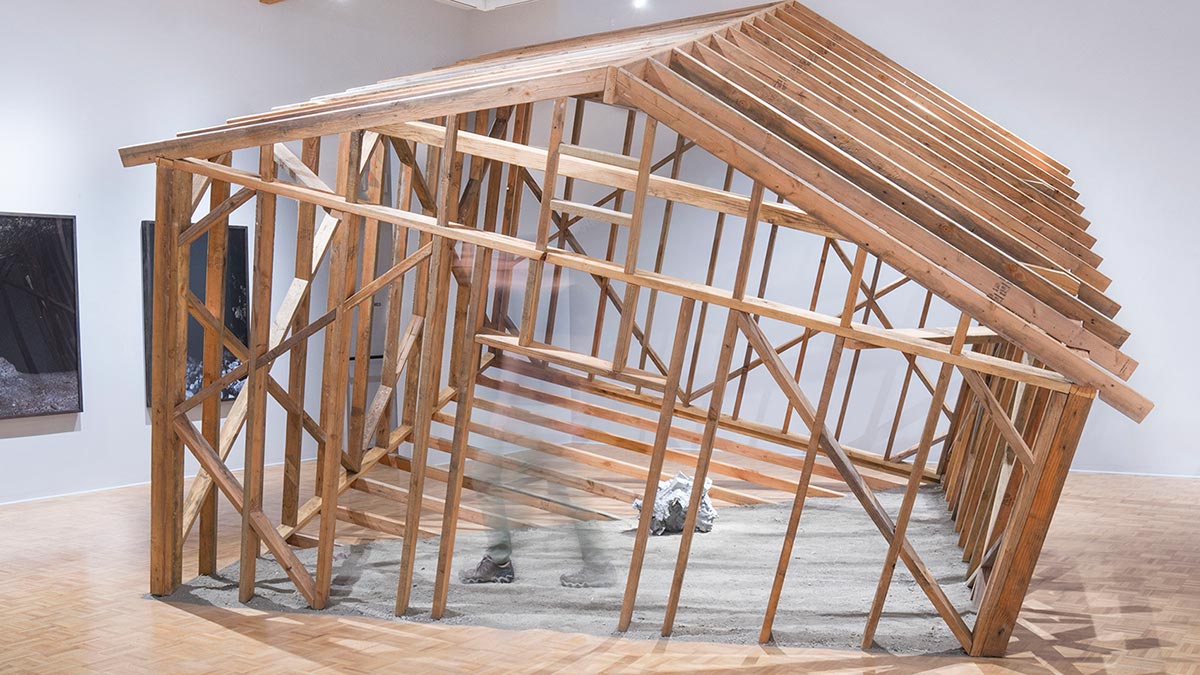
This article is part of the ongoing Come to Your Census: Who Counts in America? experience. This collaboration with Art+Action is part of their COME TO YOUR CENSUS campaign—powered by San Francisco’s Office of Civic Engagement and Immigrant Affairs (OCEIA)—which hopes to mobilize the public to take the 2020 U.S. Census. We want everyone to be counted and receive their fair share of funding and political representation for their community.
If you have not already done so, we highly encourage you to take the 2020 U.S. Census.
Mark Baugh-Sasaki is a San Francisco-based artist who combines industrial and natural materials to create fantastical objects and experiences. His work interrogates how we count communities in times of warfare, and how those histories live on within future generations.
Baugh-Sasaki sat down with founder of re.riddle and member of the Come to Your Census curatorial committee Candace Huey on May 15, 2020 to discuss how physical spaces hold history and political power.
Candace Huey: Hi Mark. It’s a pleasure to speak with you today and learn more about your art, your process, and your involvement with Art+Action and YBCA’s art and civic experience Come to Your Census: Who Counts in America?
Mark Baugh-Sasaki: Thank you for inviting me here. And I’m looking forward to sharing some insights about my work.
CH: Your work Between Memory and Landscape 1105-D takes form as a large scale, single family barrack, similar to the ones which housed your father and other Japanese-Americans during World War II in the internment camps, specifically northeast in Tulelake, California. You visited Tulelake prior to your construction of the installation over a period of several years to gather the earth, the dirt, and ephemera to incorporate into your work. Your work considers the ways in which historical and psychological strata are embedded into the landscape, and how physical structures shape our notions of home, identity and human experience. How did you go about selecting these materials? Can you share what insights you gained about yourself or your father from the process and creation of this work?
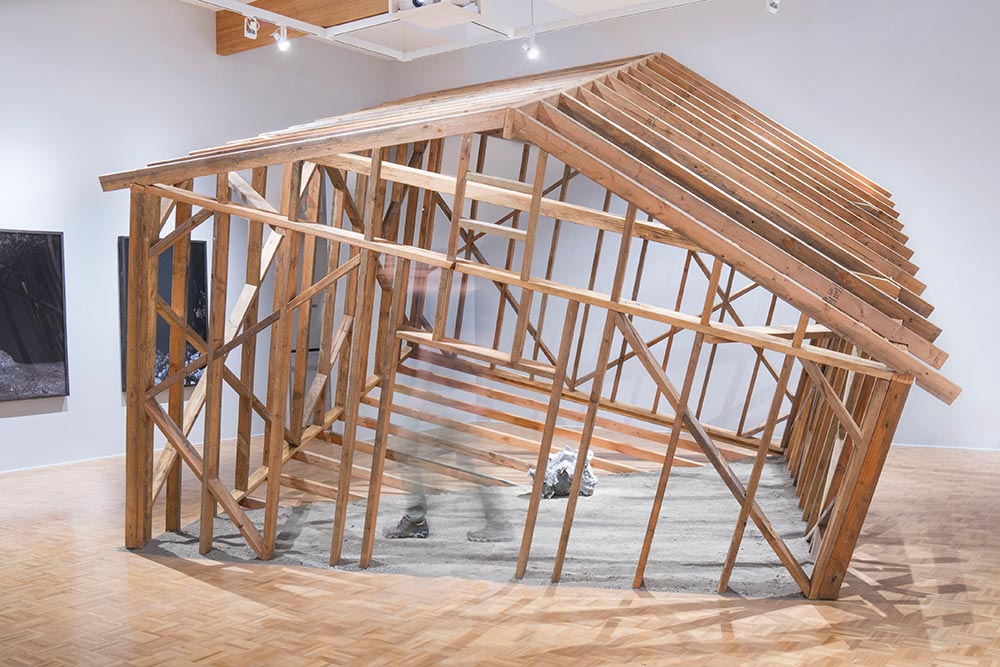
MBS: I was thinking about our relationships to land and our connection to place. I use photography a lot as a way of going to a place–as a way of sketching and recording interactions that I don’t necessarily see at the time. When I come back to the images, relationships often begin to emerge from that. I’ve always been drawn to geology, the study of the earth, the idea of geologic time and scale and how our experiences and human history are intertwined. And so I’m drawn to materials that exude that layering within the landscape. I was particularly drawn to a door I found in an old barrack from Tulelake Segregation Center that had eventually been turned into a private residence and then finally abandoned. When I saw the door I could not help but think about all the people who touched it and used it. I was also particularly drawn to the dirt, much in the same way as the door. It’s something we touch, we live on, and we inhabit. I really enjoyed that relationship between the materials and ourselves. They became records of our touch. In geologic time these materials become embedded into our surroundings. They become the land. While on a more ephemeral and human-scale timeframe, we leave fleeting impressions of our time in the space–the marks tractors and trucks leave, people’s footprints, hand prints, and more.
“I was conflicted between the beauty of the landscape, and the psychological weight of the historical events that transpired in that space.“
So that’s kind of what I was looking for in terms of materials that I was drawn to for the site. The insights that I gained about myself and my dad emerged from thinking about how I experience a place–a lot of my work is really about that. It became a way of exploring my family’s connection to the site and surrounding area of the Tulelake Segregation Camp. It became a way of understanding my perceptions of a place and how we form them. I was conflicted between the beauty of the landscape, and the psychological weight of the historical events that transpired in that space.
As for my dad, when we went up to Tulelake together, it was interesting to see the way he talked about his experience. Even though many of the original structures still exist, the place was completely different than he remembered. As we talked about it, the idea began to emerge that places exist for specific moments in time. And so in his case, returning of his own free will versus a prisoner was a very different experience. I think that place no longer existed for him physically.
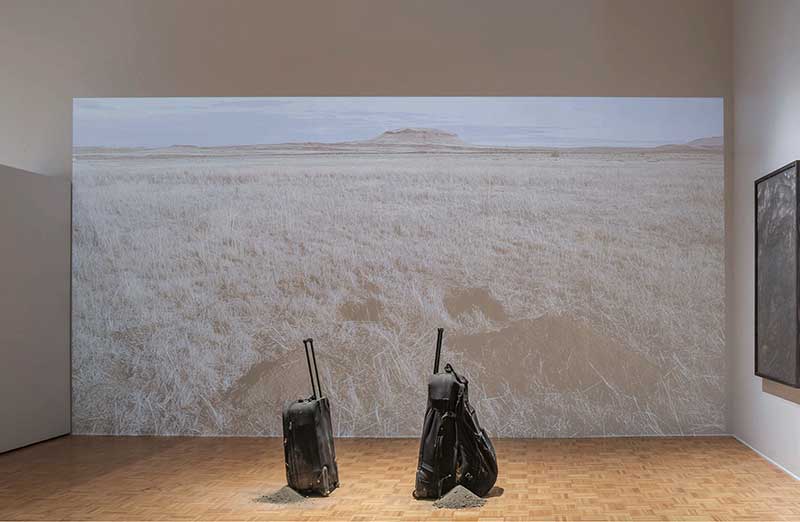
CH: Might it be described that the perception of time and place have a dialectical folding into one another?
MBS: Yeah. Or maybe they just don’t carry through time. Sites are not static when something happens. It does not stay the same, it’s ever shifting. That always changing context is a large factor in how we experience place. It is very individualistic. It’s not something that you can make grand gestures about and say, “You all should experience this place in this way.”
I think that’s one of the reasons why I’m drawn to geology as a metaphor for that, because of the way the earth shifts, folds, layers, changes, exposes and hides and all those different experiences. It’s kind of a great metaphor for history and human experience.
CH: What may be some of the anticipated experiences of the viewer as he/she/they interact with your piece?
MBS: My piece is made up of a barrack-like structure that contains a dirt floor, and then an amorphous geological object that sits on the center of the floor. It looks like some kind of rock or meteor. I wanted to create a room that people could enter into. The piece creates not just physical space, but also a psychological space. By entering into the room/building, you begin to feel enclosed or encapsulated and are invited to consider the object sitting on the dirt floor.
The idea behind the “stone” in the center of the piece is to tie geologic processes that happen around us with those that happen within us. I’m using stones produced within the body, like gallstones, kidney stones or other calcifications, and to use them as metaphor for how traumas, memories, or experiences can coalesce and be passed down genetically from generation to generation. I’m thinking about that coalescing of experience into something physical. And so that’s kind of what that object is.
“I’m drawn to geology as a metaphor for that, because of the way the earth shifts, folds, layers, changes, exposes and hides and all those different experiences. It’s kind of a great metaphor for history and human experience.”
In this space, in this container, in this mind space, the barrack or the structure creates a relationship to the viewer. The door you enter through is very specific in its height because it’s referencing a Japanese tea house. In a traditional tea house the door is often very low. It’s generally small and you have to crawl through it. It is meant to humble those who come in. It doesn’t matter whether you’re rich or poor. The idea is, as you step into this space, you have to kind of duck into the space and kind of humble yourself as you come in.
With this piece, I wanted something to leave with you. Whether it’s an emotional response or something you physically take away with you. When talking with a lot of Japanese Americans that were in the camps. Most people remember the dust and the earth and how it was on everything and was everywhere. So for me, the dirt is kind of a real symbol of that experience. As viewers come into that space, they’ll notice they’re leaving their footprints in the earth, it’s accumulating new marks and experience of all these people coming into this space. I kind of love the fact that the piece will remain with them, whether or not it remains with them in memory or through the dirt on their shoes.
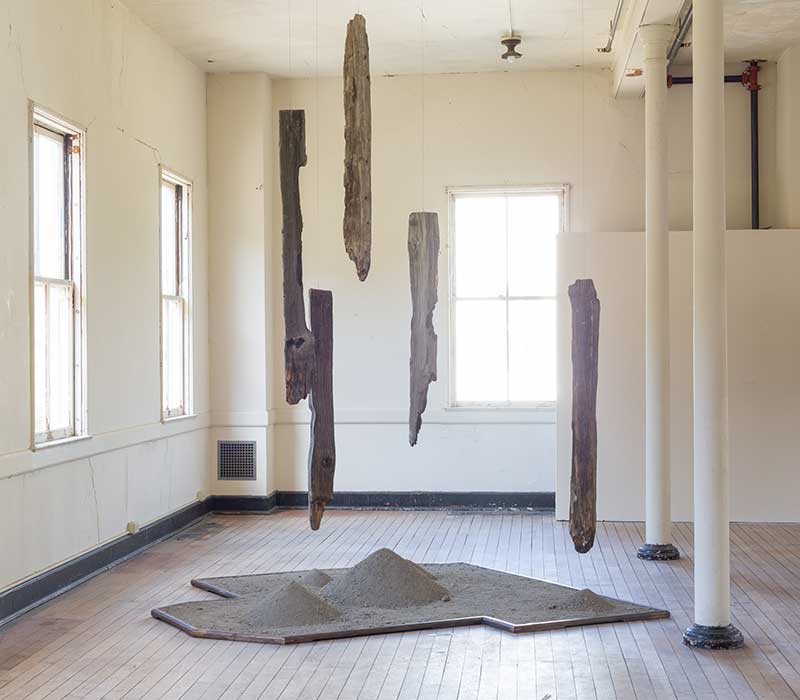
CH: How would you describe the layering of memories within the landscape?
MBS: The idea of layering memory in the landscape relates to the geological process of stratification. A process in which the bedrock of our landscapes are created. Instead of the layering of sediment and rock, it is more a hybrid of the physical and the experience being laid down on top of each other to then create our modern landscapes. It creates the presence within a space.
CH: How might the notion of legacy and/or lineage work into your piece?
MBS: The materials for this piece could be considered non-archival and will, eventually in the geologic scale of time, return back to the earth. So I’m thinking about my work, both on that scale and on a human scale with what I want to leave with people. And so for me, I’m trying to leave a way in which people consider how they interact with and how to see and perceive the world around them. But also thinking about how the site itself, or place itself, can influence how you perceive your surroundings. I think that’s what I want to leave people with, a way in which to think about how they exist within their world.
CH: Speaking of implicating the viewer in the work, thereby engendering collective histories and multiple narratives to be layered within, in what ways is taking the Census crucial for those most vulnerable in your community?
MBS: I think about my community that I live in. I live in the Bayview Hunters Point neighborhood, and my studio is there too. It’s a neighborhood that has been historically underrepresented and is an important community and cultural hub of the African American population in San Francisco. It’s imperative that people in our neighborhood are counted, and counted accurately, so they can receive the representation and allocation of resources to grow and thrive.
CH: How is Between Memory and Landscape, 1105-D political?
MBS: Well, I was seeing similarities in the historical context of the work with what is happening now with the detention of children along the border and the policies of the U.S. government towards immigrants and undocumented people, especially those from Central and South America. I’m thinking about how we treat immigrants and how we talk about undocumented people. We’ve gone through this so many times and our cultural and societal memory is so short that we don’t see similarities in our mistakes throughout our history. I really wanted to explore my connection to the imprisonment of Japanese Americans during World War II to bring that conversation back to the way we demonize immigrants in the U.S. and to hopefully engage people in conversations about both the internment and contemporary issues and events surrounding immigration.
CH: Thank you Mark, for the very thoughtful and insightful conversation.
CANDACE HUEY
re.riddle’s founder and principal, Candace Huey, brings her extensive knowledge of and experience in the art world to her projects. Huey has worked for the Fine Arts Museums of San Francisco, Bonham’s auction house, Alameda County Arts Commission and various galleries in the Bay Area where she curated exhibitions showcasing the work of 20th century masters and contemporary artists. As an independent curator, she conceptualized and produced exhibitions for cultural institutions such as Chinese Culture Center of San Francisco, Consulado General de México, Consulado General de España, and Consulat Général de France, San Francisco. She consults on collection portfolio and development for private clients in San Francisco, Hong Kong, Chicago, London and Paris.
Huey holds degrees from The Courtauld in London and U.C. Berkeley, and has presented her academic research on 17th century Dutch Art at renowned conferences in the United States and the Netherlands. She currently teaches art history at a private university, sits on the executive council for SECA SFMoMA, de Young Museum College Programs Advisory, ArtTable and is an active member of Artadia San Francisco Council and Headlands Center for the Arts.
Lead image: Mark Baugh-Sasaki, Father and Son (image), Suitcases, Earth from Tulelake Segregation Center, video projection, 2018. Courtesy of the artist.

